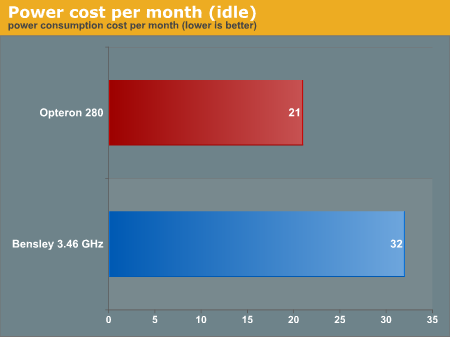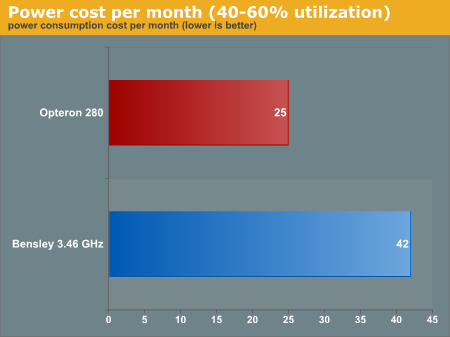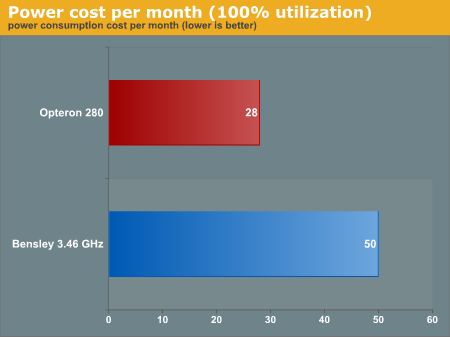Intel’s Dual-Core Xeon First Look
by Jason Clark & Ross Whitehead on December 16, 2005 12:05 AM EST- Posted in
- IT Computing
How does power consumption affect the bottom line?
We've illustrated each system's power consumption levels at different load levels. For the technical folks, those numbers are important. But, for the platform decision maker, the CTO, Director of Technology and any person in a role that looks at the bigger picture, it's important to illustrate how it affects the bottom line. Obviously, if you use more power, it costs you more money. To illustrate this, we used a current rate of 14 cents per kWh, which was taken from a power bill of a resident in Connecticut, New York. We then used the data to extrapolate the cost of each platform at the various load levels.
At 40-60% load, it costs $42 a month to run a Bensley system while an Opteron system would cost $25. Factor that over a year, and a Bensley system would cost $504 to run and an Opteron would cost $300. Now, if that doesn't pique your interest, let's say that you have 40 servers at a datacenter, with the same power characteristics. Over a year, it would cost you $8,160 more to run the Bensley system.
So, you've read through the article and are waiting for us to tell you what platform is better. That entirely depends on what matters to you: performance, power, or both. If all you care about is performance, then Bensley is that platform. If you care about how much power you consume, then Opteron is that platform. Now, if you want the best performance per Watt, then Opteron is that platform. At least that is what the database test results that we've shown here dictate. Obviously, given Intel's roadmap, they are developing platforms to address performance per Watt. Woodcrest will be the first product that is focused on performance per Watt, which we will see in the second half of 2006. Until then, the choice is yours.
We've illustrated each system's power consumption levels at different load levels. For the technical folks, those numbers are important. But, for the platform decision maker, the CTO, Director of Technology and any person in a role that looks at the bigger picture, it's important to illustrate how it affects the bottom line. Obviously, if you use more power, it costs you more money. To illustrate this, we used a current rate of 14 cents per kWh, which was taken from a power bill of a resident in Connecticut, New York. We then used the data to extrapolate the cost of each platform at the various load levels.
At 40-60% load, it costs $42 a month to run a Bensley system while an Opteron system would cost $25. Factor that over a year, and a Bensley system would cost $504 to run and an Opteron would cost $300. Now, if that doesn't pique your interest, let's say that you have 40 servers at a datacenter, with the same power characteristics. Over a year, it would cost you $8,160 more to run the Bensley system.



So, you've read through the article and are waiting for us to tell you what platform is better. That entirely depends on what matters to you: performance, power, or both. If all you care about is performance, then Bensley is that platform. If you care about how much power you consume, then Opteron is that platform. Now, if you want the best performance per Watt, then Opteron is that platform. At least that is what the database test results that we've shown here dictate. Obviously, given Intel's roadmap, they are developing platforms to address performance per Watt. Woodcrest will be the first product that is focused on performance per Watt, which we will see in the second half of 2006. Until then, the choice is yours.










67 Comments
View All Comments
Furen - Friday, December 16, 2005 - link
I must say that performance is very good on these (seriously). The cost may be a bit prohibitive (then again, decent servers are always expensive as hell) since it introduces FB-DIMMs (and 4 channels for this performance). Also, I would like to see someone test these at a 667 FSB just to see how much of a choke point it becomes, since every Dempsey besides the top end 3.46GHz one will use this (I think).Beenthere - Friday, December 16, 2005 - link
Intel holds a Dog & Pony Show for some hand picked journalists it feels will be "Intel friendly" as a result of getting the "scoop" over the mainstream PC media on Intel products as far as three years off. Then Intel proceeds to provide prototype CPUs for testing months if not years before they will actually be available. What a manipulation of the media and public opinion.This is damage control in action folks. Intel is desperate to save face and as many customers as it can while it hopelessly tries to deliver some competitive product in a year or two. The problem is AMD is so far ahead in technology, they can just release better CPUs any time they desire and Intel has nothing to counter AMD's superior products. Even the Intel fanboys and "media friendly journalists" have had to admit that purchasing an Intel product now or in the foreseeable future would be a very poor investment.
The bad situation Intel is in couldn't happen to a nicer, more deserving company IMNHO.
ElJefe - Friday, December 16, 2005 - link
Bensley. thats a gay name.The chip does nicely though.
i hope opteron makes something nicer. i mean, just increase the speed .2ghz on the chip and it will most likely blow it away and still not be power hungry.
hm.
1st
Brian23 - Friday, December 16, 2005 - link
The cost per month is wrong.Example:
The intel chip pulls 479W at 100% load.
In 24 hours, that's 24*479 = 11496W/d
Assume 31 days in a month, thats 11496*31 = 356,376W/m = 356kWh/month
Assume 14 cents per kWh 356*0.14 = $49.89 dollars per month
coldpower27 - Friday, December 16, 2005 - link
Actually I think I agree with you.1 kWH = 3,600,000J
Worse Case Scenario
479W = 479J in 1 Second, 1,724,400J in 1 Hour, 41,385,600J in 1 Day, 1,282,953,600J in 31 Days.
Divide by 1 kWH = 3,600,000
= 356.376kWH
Multiply by 0.14/kWH
= $49.89 Per month, the above poster is correct.
coldpower27 - Friday, December 16, 2005 - link
The actual difference between running 40 Opteron Systems & 40 Bensley Systems for 1 Year @ 40-60% Load comes to a difference of $5890.4 ~ 1/10 the amount Anandtech reports.
coldpower27 - Friday, December 16, 2005 - link
Disregard, used money figures of 172 and 292 for Wattage Oops :P.coldpower27 - Friday, December 16, 2005 - link
In regard to $5000 ish figure.Furen - Friday, December 16, 2005 - link
The difference is around $8140 for 40-60% load (which is realistic) and around $10,500 ($23,500 compared to around $13,500) for full load.The problem, however, is that the system's power consumption is not the only thing a data center deals with. The more power the system uses, the more heat it throw off. Energy consumption for cooling can match the system's power consumption. Another thing to take into account is the AC-DC and DC-AC power conversion inefficiencies (this is before even hitting the system's power supply, which will lead to even more inefficiency) which will probably add another 20-30% to the real power consumption. So instead of having a difference of $8140 you end up with a difference of $19,536, and that's assuming that you don't need to purchase any new equipment aside from the 40 servers themselves. Another VERY important thing is power density. You could conceivably throw 64 1U systems onto a single rack using Opterons, with a ~17KW peak power draw, but 64 1U Benseley systems would require a peak power draw of ~31KW, not to mention that it's probably very stupid to stick 2 Dempseys into a 1U system (but hey, I'd say the same thing about sticking 4 dual-core Opterons onto a 1U system but people still do it).
That is not to say that Anandtech's data is right, 'cause it isn't. I just wanted to point out that though measuring power consumption in itself is important, trying to draw conclusions from the power consumption BY ITSELF is not very useful, since it ignored all other related costs and limitations.
coldpower27 - Friday, December 16, 2005 - link
How does a difference of $8140 increase to $19,536 which is an increae of over 130%?